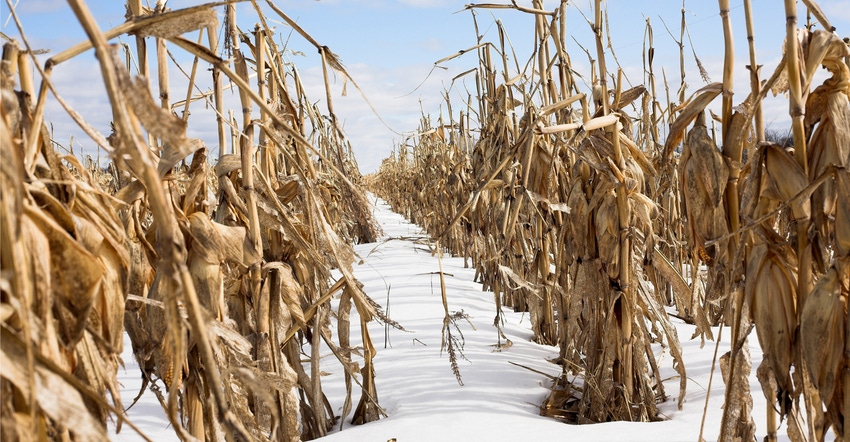November 4, 2019

Some areas of eastern Iowa picked up between 2 and 7 inches of snow late last week. The 2019 harvest season’s first snowfall, overnight on Oct. 30 and continuing into Oct. 31, was lighter in most of the state. Central Iowa only had 1 to 2 inches. But with two-thirds of Iowa’s corn crop still in the field and many soybeans still awaiting harvest, snow on standing crops raises questions. What about possible yield loss and quality damage? Snow accumulation can take its toll the longer harvest is delayed.
“It doesn’t happen every year, but snow accumulation before harvest is complete does occur periodically,” notes Mark Licht, Iowa State University Extension cropping systems agronomist. He provides these tips and considerations for dealing with this unique situation:
The probability of a first snow sticking around is fairly low, but patience is needed to allow the grain and soil conditions to dry before resuming harvest. Whenever possible, wait for the soil conditions to be favorable to avoid compaction and rutting, and avoid or minimize tillage in fields with high soil moisture. This may mean waiting for the ground to freeze.
Harvesting after snow
Harvesting corn or soybeans after snow can be problematic. Wetting and freezing causes split pods and seed shattering in soybeans, while crops with wet pods and husks can also be problematic because evaporative cooling may cause plant material to stick to the grain. This results in problems with cleaning the grain properly and is most troublesome when air temperatures are 27 to 35 degrees F.
Harvesting grain that is frozen and wet is hard on combines and can potentially damage equipment. Take time to get the combine setting correct, take preventive maintenance seriously and make appropriate repairs.
Consider the tradeoff between harvesting wet grain (maybe as high as 25% grain moisture) with in-field yield losses due to delayed harvest. How much in-field yield loss is tolerable if the alternative is $1-per-bushel drying cost?
Standing corn can withstand overwintering given the right conditions. Grain loss due to delayed harvest is minimal in November (up to 5 bushels per acre) but has the potential to increase substantially if harvest is delayed into the winter and spring (up to 60 bushel-per-acre losses — see Table 1, which summarizes a University of Wisconsin study). Stalk lodging, ear drop and wildlife feeding are the main causes of yield loss.

Lastly, consider how a delay in harvest until spring affects next year’s crop. Consider factors like potential labor shortages, fertilizer application shifts, additional risk for volunteer corn and delayed planting.
You May Also Like




